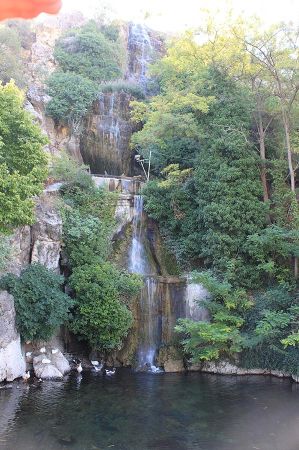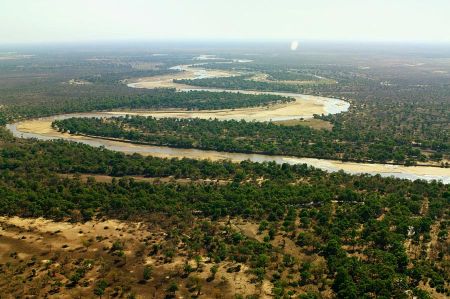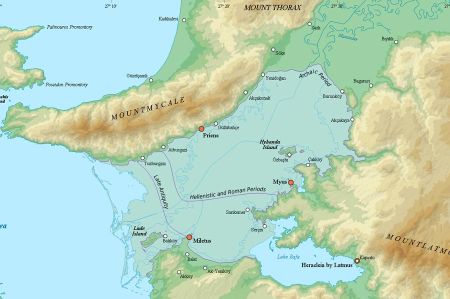The Great Meander and its little "brother"
- Written by Portal Editor
After the Euphrates and Tigris, Seyhan and Ceyhan rivers, the Great Menderes River also belongs to the group of rivers that are extremely important for agriculture and thus for the development of humanity, because when people became sedentary, they were dependent on fertile soil and a constant supply of water.
It is therefore not surprising that large rivers all over the world are particularly important in the development of human civilizations.
The Great Meander flows past Denizli

It is particularly important here that the Great Menderes is the actual namesake of the so-called river meanders, a river course that meanders like a snake through a gently sloping plain, leaving deposits of sand and gravel in the bends. Thanks to this and the fact that frequent floods led to the deposition of sediment in the entire floodplain, the sediment deposits have been able to contribute to the wealth of agriculture since time immemorial.

The ancient city of Magnesia, which was also once connected to the sea and lay between Söke and Aydin, shared the same fate. The distances between the places alone make it clear what huge amounts of sediment the Great Menderes has deposited here over time.
Small Meander / Küçük Menderes
After just 200 kilometres, the Small Menderes reaches the Aegean Sea, where the ancient city of Ephesus had its port facilities, which today attract thousands of tourists every year. These port facilities located at the mouth of the river had made Ephesus the largest and most influential city in the province of Asia of the Roman Empire, before this port also silted up due to sediment deposits from the small river.
The ancient Meander River, known today as the Büyük Menderes in Turkey, has long captured the imagination of historians, geographers, and travelers alike. Its winding path through the fertile plains of Anatolia gave rise to the term “meander,” now used worldwide to describe a serpentine river course. But what many don’t know is that the Meander has a lesser-known counterpart, a smaller “brother,” that shares its region and charm. Let’s explore the fascinating tale of these two rivers and their historical and geographical significance.
The Great Meander: A River of History
Origins and Geography
Cultural Significance
In antiquity, the Meander River was more than just a geographical feature; it was a lifeline for the cities of Miletus, Priene, and Didyma, which thrived along its banks. These cities were key players in the Ionian League and significant centers of trade, culture, and philosophy.
Symbolism in Literature and Art
The river’s winding path became a metaphor for wandering journeys and the unpredictable twists of life. Writers like Herodotus and poets of the classical era often referenced the Meander as a symbol of beauty and complexity.
The Little Brother: Küçük Menderes
Geographical Overview
Historical Importance
The Küçük Menderes nourished the ancient city of Ephesus, one of the most prominent cities of the classical world. Ephesus, home to the Temple of Artemis—one of the Seven Wonders of the Ancient World—relied on the river for agriculture, trade, and transportation.
A Tale of Two Rivers
Unlike the Büyük Menderes, which retained much of its natural course, the Küçük Menderes was prone to silting. Over centuries, this caused Ephesus to lose its access to the sea, contributing to its eventual decline.
The Rivers Today: A Journey Through Time
Both rivers remain vital to the region's agriculture, supporting the cultivation of cotton, olives, and citrus fruits. However, like many rivers worldwide, they face challenges such as pollution and overuse.
Tourism and Exploration
Visitors to Turkey can explore the legacy of these rivers by visiting ancient ruins like Miletus and Ephesus. The scenic landscapes along their courses, dotted with small villages and natural beauty, offer a glimpse into the past and present of Anatolia.
The Meandering Legacy
The Büyük Menderes and its smaller counterpart, the Küçük Menderes, are more than just rivers. They are storytellers of history, culture, and nature, winding their way through the heart of Turkey and shaping the land and civilizations around them.
Whether you’re a history enthusiast, a nature lover, or an adventurer, these rivers invite you to explore their meandering paths and uncover the stories they hold. In their twists and turns lies the essence of life itself—a journey full of surprises, beauty, and discovery.
Please also read:
